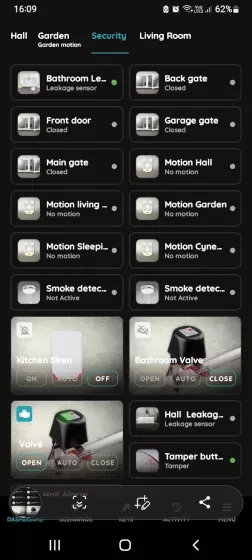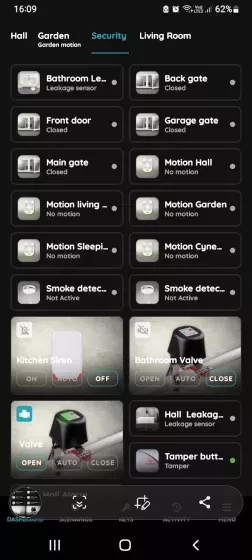On this page
The Leakage Sensors feature in the Smart PIERRE app allows users to manage and customize the sensor settings with ease. Users can edit the Leakage sensor from both the Dashboard and the I/O list from the Menu.
Key benefits of the Leakage sensor include:
- Status Visibility:
- The status of the Leakage sensor is displayed directly on the Dashboard with a green dot for Active and a gray dot for Not Active status.
2. Long Press for Advanced Options:
A long press on the sensor icon provides access to the Edit and Used In tabs for further customization. The Edit tab enables users to update the name and picture of the sensor, while the Used In tab shows the list of automations where the sensor is integrated.
3. Automation Integration:
- Leakage sensors can be easily included in custom automations. For example, you can automate a Kitchen valve to open only when the Leakage sensor is Not Active, ensuring that water flow is securely managed.
The Leakage Sensors feature ensures smooth integration with the PIERRE smart home system, allowing for seamless automation and customization. This system offers a proactive solution for managing potential water leaks, making it an essential part of any smart home setup.
Leakage sensor has got two status indicators.

When leakage is detected, green dot as an indicator of this status is visible next to the Leakage sensor.
In this case, Bathroom Leakage sensor has got green dot.

When leakage is not detected, grey dot as an indicator of this status is visible next to the Leakage sensor.
In this case Bathroom Leakage sensor has grey dot.
To edit the Leakage sensor settings, follow next steps.

Open I/O list, scroll to the Leakage sensors and tap on the card of the desired Leakage sensor.
In this case tap on the the Bathroom Leakage sensor.

Edit the following form:
- Name - Edit the name of the Leakage sensor.
- Photo - Choose the source of the photo.
Tap the Submit/Done.
GOOD TO KNOW:
Leakage sensor can be edited by long-press the Leakage sensor card on the Dashboard or tapping it in the I/O list.

You have four options:
Open Library - The phone’s Library will open.
Open Camera - You can take a picture using your smartphone.
Choose default image - These images are prepared in advance in order to provide a complete and seamless experience.
Remove image - Removes existing image.
The Used In tab shows all the scenarios and automations where the Leakage sensor is applied. If it isn't used in any, the list will be empty, and a message will display: "This I/O is not in use anywhere." This feature is particularly useful as it consolidates all relevant information in one place.

In this case Bathroom Leakage sensor is used for automation of the Bathroom Valve.
If you want to change the status of the Valve On or Off based on a sensor or trigger, it needs to be set here. If any I/O needs to be automated, it should be set up here.
Valve will be open when Leakage sensor is not active.
You can find Valve on the Dashboard or on the I/O list.

Tap on the Bathroom Valve on the Dashboard in order to open it and add automation for it.
Or open I/O list from the Menu and find it there.

Open Menu, under Settings, tap on the I/O from the Menu.

Open I/O list, scroll to the Valves and tap on the desired Valve, in this case on the Bathroom Valve.

Tap on the tab Automation.

Tap the +Add new Automation.

There is possibility to add:
- New Time condition,
- New Delay,
- Existing I/O.
Tap on the Existing I/O from the list.

Open I/O list, scroll to the Leakage sensors and tap on the card of the desired Leakage sensor.
In this case tap on the the Bathroom Leakage sensor.

Bathroom Valve will open when Bathroom Leakage sensor is not active.
Tap the button Not Active.
Tap the button Save.

To confirm settings of the automation tap on the button Done.


